Images and texts found in ancient Egyptian burials present a highly complex vision of the afterlife. In particular, the specialized decoration employed in royal tombs provides unparalleled insight into the Egyptian understanding of death as an interface between the human and divine worlds.
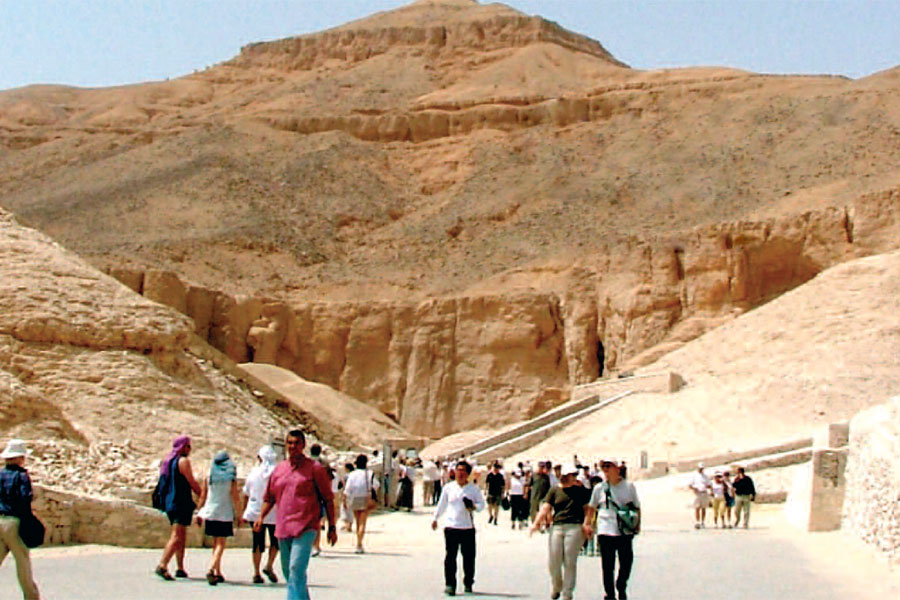
The Valley of the Kings—located on the west bank of the Nile River at Thebes near modern Luxor—was the site of Egypt’s royal necropolis during the New Kingdom (ca. 1569–1081 BCE). Containing the tombs of almost every pharaoh of the 18th, 19th, and 20th Dynasties, it appears to have been chosen, at least in part, for certain geographical peculiarities that held specific religious significance for the ancient Egyptians. A great peak—known in modern Arabic as el-Gurn (“the horn”)—dominates the eastern approach to the Valley and serves as a natural pyramid for the many tombs below. At the same time, the sides of the Valley, when viewed from the east, recall the twin hills employed in the Egyptian hieroglyph representing the akhet,![]() , the point at which the sun enters and exits the visible sky and which may be translated loosely as “horizon.” Given that the daily rising and setting of the sun served as the model for the king’s own resurrection, the akhet-shaped cliffs combined with the natural pyramid of the Gurn made the Valley an ideal place for the establishment of a new royal burial site.
, the point at which the sun enters and exits the visible sky and which may be translated loosely as “horizon.” Given that the daily rising and setting of the sun served as the model for the king’s own resurrection, the akhet-shaped cliffs combined with the natural pyramid of the Gurn made the Valley an ideal place for the establishment of a new royal burial site.
All of the Valley’s tombs are rock-cut, subterranean monuments that lack substantial aboveground superstructures (although carved gateways were eventually added after the 18th Dynasty). Their essential features include paired statue niches near the beginning of the tomb entrance, a series of sloping corridors connected by short stairways, a deep “well shaft,” and pillared sarcophagus hall.
While the earlier 18th Dynasty royal tombs followed distinctively curved axes, after the reign of Hatshepsut (ca. 1502–1482 BCE), the structures began to adopt more angular, bent forms. These bent axes, in turn, gave way to a linear axis during the reign of the heretic pharaoh Akhenaten (ca. 1372–1355 BCE), who constructed his tomb outside the Valley of the Kings, near his new capital of Akhetaten. But whereas subsequent kings returned to the Valley, variations on the older bent axis only re-appeared twice more—first, in the hastily prepared tomb of Tutankhamun (ca. 1346 BCE) and later in that of Ramesses II (ca. 1237 BCE). All of the remaining pharaohs of the later New Kingdom employed predominantly linear tomb designs.

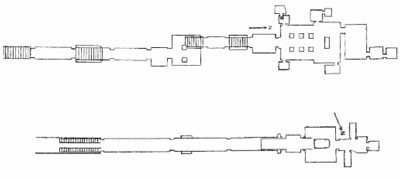
The Amduat Tomb
Royal tomb architecture and decoration was connected intimately with the Egyptian conception of the Duat, a mythological region understood during the New Kingdom as a subterranean “Underworld.” Our principal source of knowledge concerning the Underworld during the 18th Dynasty is a cosmographic treatise known to the Egyptians as the “Writing of the Hidden Chamber” and referred to most often in modern literature by the more generic Egyptian title of Amduat (literally, “What is in the Underworld”). This book consisted of a series of vignettes and texts arranged in linear fashion to depict the 12 regions of the Duat, which the sun god Re traversed during each corresponding hour of the night, prior to his rebirth at dawn from the eastern horizon.
The curved and bent axes employed in royal tombs through most of the 18th Dynasty were probably intended to reflect the tortuous, serpentine paths of the Underworld itself. This equation is implicit, for instance, in the technical term, “god’s passage,” that Egyptian architects used to describe a tomb’s sloping corridors, drawing upon stock phraseology employed in texts like the Amduat with reference to the sun’s travels through the Underworld. In addition, however, individual tomb chambers might also represent more specific regions within the Duat. For example, scholars such as Friedrich Abitz have associated the deeply cut “well shaft” with the “Cavern of Sokar” described in the Amduat’s fifth hour.
Of course, the most important chamber was that which housed the physical corpse of the king––the sarcophagus hall—that the Egyptians designated “the House of Gold in which One Rests.” In the New Kingdom, this chamber always occurred at or near the end of the tomb. Prior to the reign of Amenhotep II (ca. 1454–1419 BCE), such chambers exhibited a semi-ovoid, or “cartouche-shaped,” design. Egyptologist Erik Hornung has suggested that this shape might reflect the similarly curved concluding representation found at the end of the Amduat.
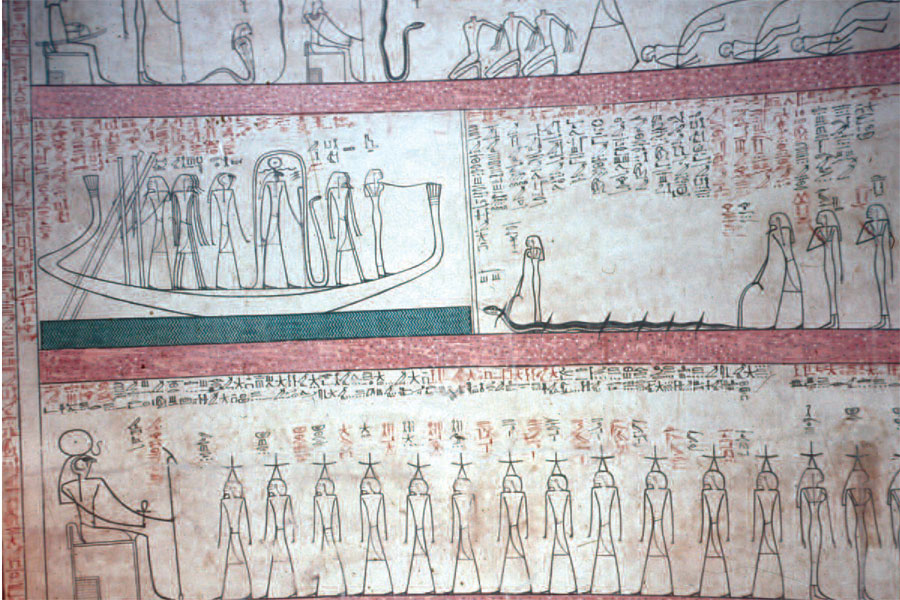
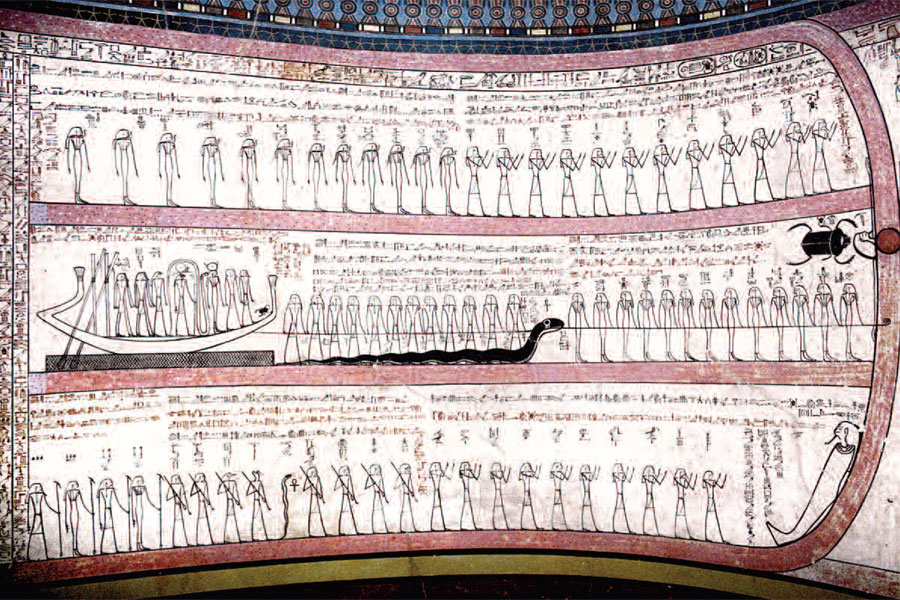
In this regard, it becomes significant that sarcophagi during the 18th Dynasty tended to be placed at the rear of the chamber, near the center of the back wall. As a result, the king’s corpse rested within the 3-dimensional sarcophagus hall at a position corresponding to that of the rejuvenated sun as found in the 2-dimensional Amduat concluding scene.
The ideal placement of the Amduat itself on the walls surrounding the sarcophagus chamber would have further reinforced this association. Thus, in the tomb of Thutmose III (ca. 1452 BCE), the book’s concluding representation terminates at the curved juncture of the rear and right-hand walls, kitty-corner to the king’s nearby sarcophagus, at a position designated explicitly in the text as the “eastern side of the Hidden Chamber in the Duat.” Here, even the red coloration of the quartzite sarcophagus mimics the red of the nocturnal solar disc in the Amduat’s conclusion. At the same time, the lighter yellow within the stone, visible in the incised hieroglyphs, hints at the color that the reborn sun will assume in its mature, daytime form, even as the king awaits his own rebirth as a manifestation of the god within the sarcophagus itself.
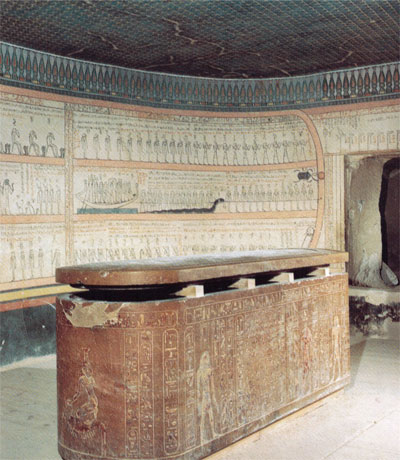
The Ramessid Tomb Plan
The development of the New Kingdom royal tombs from the 18th Dynasty into the following Ramessid Period (19th and 20th Dynasties; ca. 1315–1081 BCE) suggests a trend toward increasing schematization whereby the structures progress from more literal cosmographic models of the Underworld to increasingly abstract architectural metaphors.
While the earlier 18th Dynasty “Amduat-style” tombs exhibited cartouche-shaped (semi-ovoid) burial chambers and curved axes, by the second half of that Dynasty, oblique and, later, right angles came to dominate the entire structure. During this transition, the basic, 4-room ground plan was doubled, creating a “fossilized” sequence of corridors, antechamber, and pillared hall, followed by a second set of corridors, the well shaft, and pillared sarcophagus chamber. The bent axis of the later 18th Dynasty tombs commenced from the first pillared hall, creating a vaguely L-shaped con- figuration that served to differentiate the initial, fossilized sequence of rooms from the second half of the tomb.
By contrast, nearly all of the kings of the following Ramessid Period employed some form of linear tomb axis. The disappearance of the older, bent shape eliminated any overt architectural reference to the twisting labyrinth of the Duat. However, the sequence of individual corridors and rooms remained essentially unaltered, preserving the relative order of their presumed mythological counterparts in the Underworld.
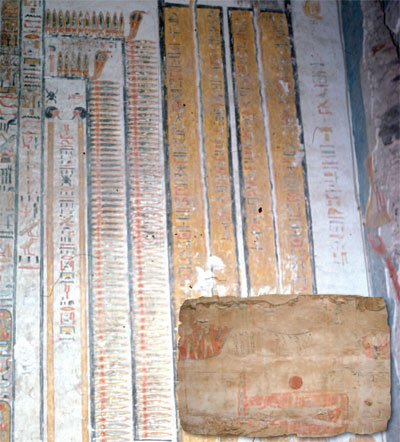
The Later Books of the Underworld
In terms of wall decoration, the Amduat continued to appear in the Ramessid Period tombs, although it was no longer reserved for the sarcophagus hall and now appeared frequently in the preceding corridors. In addition, a number of new “Underworld Books,” such as the “Book of Gates” and the “Book of Caverns,” began to appear at this same time, offering alternate, yet largely complimentary, representations of the sun’s linear progress through the Duat.
In the 18th Dynasty, decoration of the rooms preceding the sarcophagus chamber was limited mostly to representations of the king and certain deities. From the 19th Dynasty onward, once the Underworld Books began to appear outside of the burial chamber, the entire tomb became a canvas for representations of the mythological regions of the hereafter. Significantly, this development took place only after the abandonment of the bent axis in favor of more linear tomb designs. By including explicit Underworld imagery throughout the descending corridors and other rooms, the Ramessid architects effectively labeled the entire structure as “the Underworld,” without the necessity of replicating its serpentine course in the axis of the tomb itself.

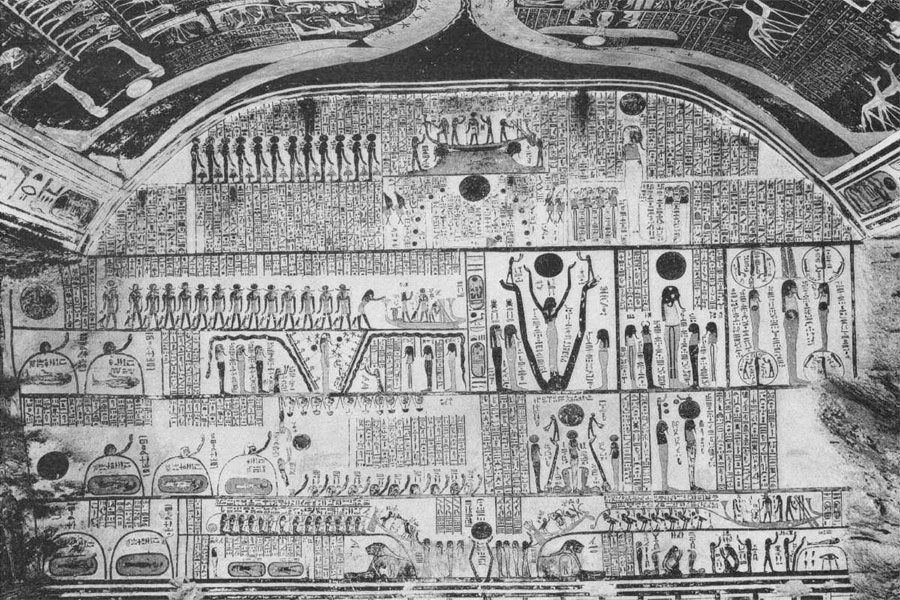
Architectural Development of the “Akhet-Style” Burial Chamber
The extension of the Underworld Books beyond the sarcophagus hall also coincided with a re-configuration of that room’s architecture, apparently intended to emphasize its role as the deceased king’s personal horizon.
During the 18th and early 19th Dynasties, the burial chamber ran lengthwise along the major axis of the tomb, with the sarcophagus placed off-center near the rear of the hall, beneath a flat ceiling. The ceiling was decorated with a simple field of stars on a dark blue background, while the primary wall decoration consisted of the Amduat, which ideally (although rarely in practice) reproduced the 12 divisions of the Underworld in a specific sequence around the chamber’s circumference, re-creating the circuit of the sun’s nocturnal voyage.
This design changed during the reign of Seti I (ca. 1314–1304 BCE), the second king of the 19th Dynasty. From this point, the architects regularly rotated the rectangular burial chamber perpendicular to the major axis of the tomb, while the sarcophagus was moved to a sunken depression at the center of the chamber. In addition, the sidewalls acquired an arched shape, creating a curved vault in place of the flat ceiling found in the “Amduat-style” burial chamber.
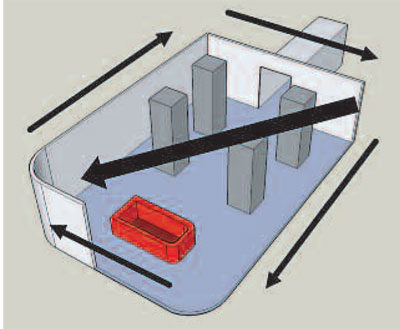
By placing the king’s body in a central depression between symmetrically paired and arching sidewalls, the architects evoked the hieroglyphic image of the akhet, the stylized pair of hills flanking the solar disc,![]() , which constituted the quintessential symbol of solar rebirth. The incorporation of this symbol into the architecture of the sarcophagus chamber—the site of the king’s own resurrection—served to magically equate the nightly rejuvenation of the sun god Re with the transfiguration of the deceased king and his ultimate rebirth as a solar deity.
, which constituted the quintessential symbol of solar rebirth. The incorporation of this symbol into the architecture of the sarcophagus chamber—the site of the king’s own resurrection—served to magically equate the nightly rejuvenation of the sun god Re with the transfiguration of the deceased king and his ultimate rebirth as a solar deity.
The Decorative Program in the Late Ramessid Sarcophagus Hall
New decorative programs employed in the “akhet-style” burial chamber further emphasized the form and function of the room as a horizon. Unlike the 18th Dynasty royal tombs, Ramessid sarcophagus chambers rarely employed the Amduat as a major component in the room’s decoration. Instead, many 19th and 20th Dynasty tombs included a new type of Underworld composition, which modern scholars have designated the “Book of the Earth.” Scenes from this composition appeared already in the cenotaph of the god Osiris built by Seti I at Abydos, but it was Seti’s grandson, Merneptah (ca. 1237–1226 BCE), who first adapted the book for use in a royal tomb.
Unlike almost all of the other Underworld Books, the “Book of the Earth” had no fixed content or order—scenes were drawn from a common pool of stock imagery and selected on a more-or-less ad hoc basis to suit the requirements of a particular tomb owner. The principal organizational feature linking the various “Books of the Earth” was their consistent division into two symmetrical halves, suitable for decorating the symmetrically paired, arching sidewalls of the new “akhet-style” burial chambers. Because the internal structure of the “Book of the Earth” was fundamentally mutable, it was probably not conceived as a “map” of the Underworld. Rather, individual elements appear to have been selected as characteristic examples representing a range of possible locations and beings that the sun god might encounter during his nocturnal journey from the western mountain of the horizon at sunset to the eastern mountain at sunrise. Thus, while the architecture of the room physically replicated the shape of the akhet hieroglyph, the “Book of the Earth” served as a magical catalyst to turn the structure “on,” transforming it into a functional, personalized horizon from which the king might affect his solar rebirth.
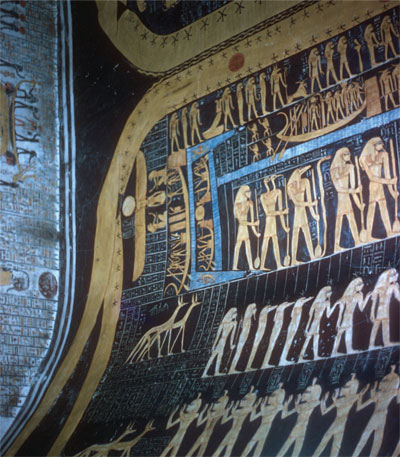
However, such horizon symbolism was not limited to wall decoration. Whereas the characteristically arched sidewalls suggest the domes of paired mountains in the horizon hieroglyph, they also lend the ceiling a distinctively curved, vaulted shape. This shape reflected the Egyptian understanding of the sky, conceptualized in the hieroglyphic script as a vaulted expanse supported by downward curving posts,![]() , a form that was often personified in representational art as the arched body of the sky goddess Nut,
, a form that was often personified in representational art as the arched body of the sky goddess Nut,![]() . In the 18th Dynasty “Amduat-style” burial chambers, the flat ceiling had been adorned with generic representations of the sky—yellow stars on a dark blue background. By contrast, every completed “akhet-style” sarcophagus hall from the 19th and 20th Dynasties included much more detailed representations of the heavens, exploiting fully the mythological significance of the vaulted ceiling as a medium for decoration.
. In the 18th Dynasty “Amduat-style” burial chambers, the flat ceiling had been adorned with generic representations of the sky—yellow stars on a dark blue background. By contrast, every completed “akhet-style” sarcophagus hall from the 19th and 20th Dynasties included much more detailed representations of the heavens, exploiting fully the mythological significance of the vaulted ceiling as a medium for decoration.
Earlier examples of “akhet-style” burial chambers— including those from the tombs of Seti I, Merneptah, Tawosret, and Ramesses III—employed so-called astronomical ceilings that depicted the northern and southern heavens and the personified constellations of the Egyptian “zodiac.” In these representations, the two halves of the sky were separated merely by two non-descript yellow bands. Later examples—including those from the tombs of Ramesses VI, Ramesses VII, and Ramesses IX—represent the double sky anthropomorphically as the twin bodies of the goddess Nut, which were associated explicitly with the day and the night.
As the mother of the sun god Re, Nut’s feet stood ideally atop the side wall corresponding to the eastern mountain of the horizon. From this position, the newborn sun would enter the visible sky—simultaneously exiting the Underworld and emerging from the thighs of his celestial mother. The course of the sun through the heavens then followed Nut’s body across the ceiling, from “east” to “west,” toward the moment of sunset. At this point, Nut swallowed the now-aged sun as he once more entered the western mountain of the horizon. The ensuing nocturnal journey back through the Duat from “west” to “east” was envisioned both as a passage through the body of the sky goddess and through the subterranean Underworld.
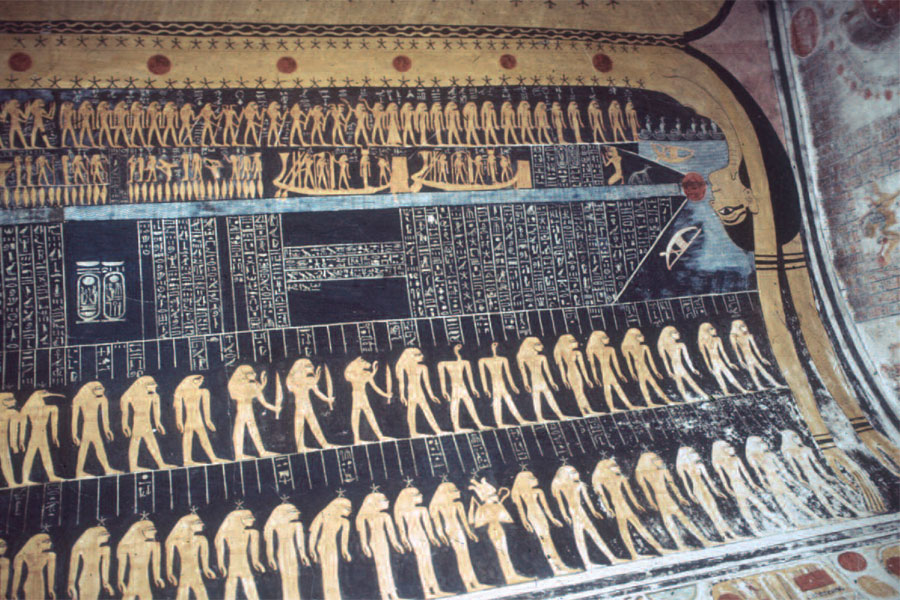
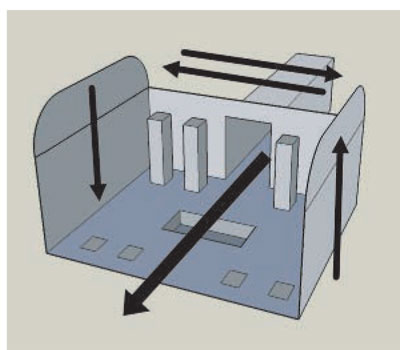
The combination of the various “Books of the Earth” on the arching sidewalls and the celestial representations on the vaulted ceiling created a powerful image of solar rebirth from the horizon, in which the corpse of the deceased king occupied the central position as the sun itself. The cyclical solar journey represented in the “akhet-style” burial chamber ran perpendicular to the major, linear axis of the tomb. One is tempted to see in the intersection of these two axes a reflection of the ancient Egyptian conception of the duality of time. On the one hand, neheh (“eternal recurrence”) was associated with the sun god Re and his cyclical rising and set- ting. On the other hand, djet (“eternal sameness”) was associated with the god of the Dead, Osiris. As a result of the nightly union of these two deities, the sun was able to be reborn each morning. Through the rhythm of this daily cycle, time in both its cyclical and linear aspects was perpetuated and the order of the cosmos maintained. By placing his corpse within the tomb at the intersection of these complimentary aspects of the divine, the king assured his own rebirth, rising like the sun from his personal horizon to take his place in the solar entourage and maintain order in the Egyptian cosmos.
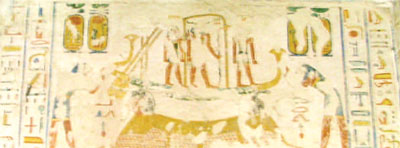
Abt, T., and E. Hornung. Knowledge for the Afterlife. The Egyptian Amduat—A Quest for Immortality. Zurich: Living Human Heritage, 2003.
Carter, H., and A. Gardiner. “The Tomb of Ramesses IV and the Turin Plan of a Royal Tomb.” Journal of Egyptian Archaeology 4 (1917):130-58.
Cerný, J. The Valley of the Kings: Fragments d’un Manuscrit Inachevé. Bibliothèque d’Étude, vol. 61. Cairo: IFAO, 1973.
Hornung, E. The Ancient Egyptian Books of the Afterlife. Translated by David Lorton. Ithaca, NY: Cornell University Press, 1999.
Hornung, E. The Valley of the Kings. Translated by David Warburton. New York: Timken, 1990.Roberson, J. “The Book of the Earth: A Study of Ancient Egyptian Symbol-Systems and the Evolution of New Kingdom Cosmographic Models.” Ph.D. dissertation, University of Pennsylvania, 2007.
Wilkinson, R. “Symbolic Location and Alignment in New Kingdom Royal Tombs and their Decoration” Journal of the American Research Center in Egypt 31(1994):79-8.
